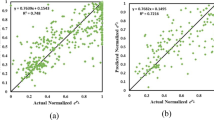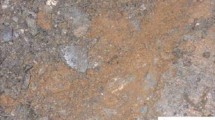Abstract
Determining the liquefaction potential of soil is important in earthquake engineering. This study proposes the use of the Relevance Vector Machine (RVM) to determine the liquefaction potential of soil by using actual cone penetration test (CPT) data. RVM is based on a Bayesian formulation of a linear model with an appropriate prior that results in a sparse representation. The results are compared with a widely used artificial neural network (ANN) model. Overall, the RVM shows good performance and is proven to be more accurate than the ANN model. It also provides probabilistic output. The model provides a viable tool for earthquake engineers to assess seismic conditions for sites that are susceptible to liquefaction.
Similar content being viewed by others
References
Bishop C (1995), Neural Networks for Pattern Recognition, Oxford: Oxford University Press.
Goh ATC (1994), “Seismic Liquefaction Potential Assessed by Neural Networks,” Journal of Geotechnical engineering, 120(9):1467–1480.
Goh ATC (1996), “Neural-network Modeling of CPT Seismic Liquefaction Data,” Journal of Geotechnical engineering, 122(1):70–73.
Haldar A and Tang WH (1979), “Probabilistic Evaluation of Liquefaction Potential,” Journal of Geotechnical Engineering, 104(2):145–162.
Juang CH, Chen CJ and Tien YM (1999), “Appraising Cone Penetration Test Based Liquefaction Resistance Evaluation Methods: Artificial Neural Network Approach,” Canadian Geotechnical Journal, 36: 443–454.
Liao SSC, Veneziano D and Whitman RV (1988), “Regression Models for Evaluating Liquefaction Probability,” Journal of Geotechnical Engineering, 114(4):389–411.
MathWork Inc (1999), Matlab User’s Manual, Version 5.3. Natick, MA: The MathWorks, Inc.
Seed HB and Idriss IM (1967), “Analysis of Soil Liquefaction: Niigata Earthquake,” J. Soil Mech. and Foun. Div, 93(3):83–108.
Seed HB and Idriss IM (1971), “Simplified Procedure for Evaluating Soil Liquefaction Potential,” J. Soil Mech and Found. Div, 97(9):1249–1273.
Seed HB, Idriss IM and Arango I (1983), “Evaluation of Liquefaction Potential Using Field Performance Data,” J. Geotech. Engrg. Div, 109(3):458–482.
Seed HB, Tokimatsu K, Harder LF and Chung RM (1984), “Influence of SPT Procedures in Soil Liquefaction Resistance Evaluation,” Rep. No. UCB/EERC-84/15, Calif: Earthquake Engrg. Res. Ctr., Univ. of California, Berkeley, 1984.
Tipping ME (2001), “Sparse Bayesian Learning and the Relevance Vector Machine,” J. Mach. Learn, 1:211–244.
Toprak S, Holzer TL, Bennett MJ and Tinsley JC (1999), “CPT-and SPT-based Probabilistic Assessment of Liquefaction,” Proc., 7th U.S.-Japan Workshop on Earthquake Resistant Design of Lifeline Facilities and Counter measures against Liquefaction, Seattle: Multidisciplinary Center for Earthquake Engineering Research, Buffalo, N.Y., 69–86.
Youd TL and Noble SK (1997a), “Magnitude Scaling Factors,” Proc., NCEER Workshop on Evaluation of Liquefaction Resistance of Soils, Nat. Ctr. for Earthquake Engrg. Res., State Univ. of New York at Buffalo, 149–165.
Youd TL and Noble SK (1997b), “Liquefaction Criteria Based on Statistical and Probabilistic Analyses,” Proc., NCEER Workshop on Evaluation of Liquefaction Resistance of Soils, Nat. Ctr. for Earthquake Engrg. Res., State Univ. of New York at Buffalo, 201–215.
Author information
Authors and Affiliations
Corresponding author
Rights and permissions
About this article
Cite this article
Samui, P. Seismic liquefaction potential assessment by using Relevance Vector Machine. Earthq. Eng. Eng. Vib. 6, 331–336 (2007). https://doi.org/10.1007/s11803-007-0766-7
Received:
Accepted:
Issue Date:
DOI: https://doi.org/10.1007/s11803-007-0766-7




